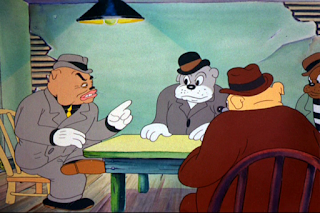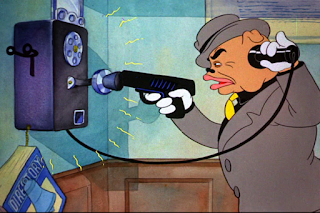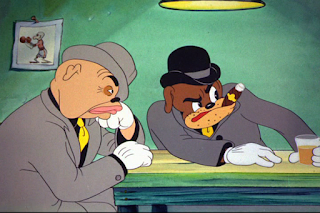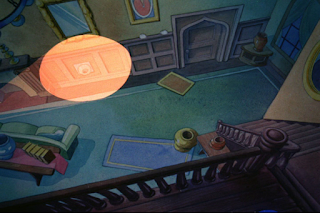DVD-Blu-Ray Availability: Looney Tunes Golden Collection Vol. Three (WHV)
You may view this cartoon HERE. (Warning--the volume control on Critical Commons videos is hidden--it's on the right side of the screen. It only appears if your mouse/finger lingers over it. Take a moment to find the volume slider:this one is LOUD!)
A stellar example of what the Fred Avery unit could produce, when inspiration and skill intersected, this cartoon is one of the director's early masterpieces. It's also a study in economy, with sequences that avoid animation and thus allow its new footage to shine with special effects and expressive, elaborate draftsmanship.
A parody of Warner Brothers' genre-defining gangster and crime movies--a staple of the late-Depression movie-going experience--was a solid idea. By spring of 1939, audiences had viewed over a decade's worth of talkie crime movies. Warners had a big one coming in the fall of 1939--The Roaring Twenties, which co-starred established James Cagney and brink-of-stardom Humphrey Bogart.
Some of these films, like Rouben Mamoulian's City Streets and Edward L. Cahn's Afraid To Talk, are impressive, moody and still of great interest. Much of the Warners/First National efforts are solid entertainments, although given to formula by the middle of the 1930s.
Long story short: this genre demanded a meta-spoof, and Avery gave it to his audience. From music to montage to atmosphere, Thugs With Dirty Mugs is both an effective satire of the gangster film and a formal romp through the biases of Hollywood movie-making.
As would a typical WB picture, we begin with "credits" that show the main characters, culled from apropos footage seen again later in the film. Other cartoons had done this gag, including Avery's, but the device sets up a delicious anticipation--and leaves no doubts as to its coming attractions:*
The screen shots are from the gorgeous restored version seen on the second disc of Warner Home Video's Looney Tunes Golden Collection III. The vibrancy of these restorations makes the viewer wish all the important early Avery cartoons had been given this royal treatment.
Among the cliches of this genre was an over-reliance on montage sequences. As with Avery's cartoon, these moments allowed resurrection of stock footage, photographs and other pre-made material, which kept operating costs down.
Here, Avery gets the most from the least. Two alternating newspapers, in time with Carl Stalling's lurid score, pound the point home for pennies:
...and so on. The headlines thump down as we ponder the significance of the tree and house photograph on the even-numbered papers.
This was a gag worth stealing, as writer-artist Dick Hall realized in his 1947 Woody Woodpecker story, "The Mad Genius:"
Though Hall's page lacks the dynamism of movement and sound, his variations on the theme are genuinely funny. Their inspiration is likely this Avery cartoon.
Back to our film presentation:
We've covered "bank nite" in a previous post. That this stock scene of genre movie-making will reveal a pinball metaphor is a whole 'nother matter. Built from organic elements (windows, fire hose connection), there's no contrivance in its set-up.
Carl Stallings' music, already integral to the Warner Brothers cartoon style, completes this gag sequence.
Bob Clampett will borrow this next gag in his rowdy 1946 gem, The Great Piggy Bank Robbery. It's a stupid joke delivered with such confidence that we forget how dumb it really is.
This is the first dialogue in the cartoon, at 1:51: "If this is the last thing I do, I'm gonna pin it on ya! I'm gonna pin it on ya, see?" It's spoken by John Deering, a familiar voice to 1930s filmgoers. (Keith Scott tells me that Deering narrated The Roaring Twenties, and was a common presence on the WB/First National previews.)
This cartoon consists of vignettes that, by parallel points of view, tie a farcical story together. A solid narrative was never high on Avery's agenda. In his mature M-G-M period, he can fashion an entire cartoon around one core gag (Rock-a-Bye Bear, Bad Luck Blackie, Billy Boy, et al). This patchwork approach is unusual for Avery, but it gives the cartoon a singular energy.
Back to business. Police chief paces; mutters to self. Cigar stays on one end of the room.
The late '30s Avery employs short-hand devices from live-action movies, then subverts them. Here is one of his earliest violations of the split-screen effect-- a live-action attempt to give oomph to tedious phone conversations...
Secret Agent 2 3/8 (voiced by Mel Blanc) phones the captain with a hot tip. The screen splits diagonally. Atmospheric moving-perspective animation of telephone poles and wires are spot-on. It gives this nonsense a momentary feel of gravity.
Killer claims: "I can do a Fred Allen, too!" He places finger to nose to approximate the nasal tones of this once-beloved radio personality.
"Aah, come on, Killer, quit showin' off," declares Blanc-voiced henchman. (To be fair, Killer's Allen routine does threaten to take up the rest of the picture.)
As with the captain's cigar, Killer's gats remain in mid-air so he can use both hands to scoop up the dough.
As well, it infers that the on-screen figures have no idea what's about to happen to them--despite their apparent consciousness of everything the audience does. That this humble patron has seen the cartoon, and knows how it ends (information not available to the otherwise-omnipotent cartoon stars) is a new and welcome wrinkle in a complex comedic idea.
Here, his mega-doses of meta-comedy--as far out as Avery ever dared to be--daze and embrace the viewer, who hangs on throughout the hairpin turns and twists of this animated ride. The humor is smart, and demands that its viewers be hep enough to get it. Those who don't can still watch and enjoy the cartoon--they just miss out on its ultimate impact.
Through the lush vehicle of the Hollywood cartoon, with its rich colors and resonant orchestral music, an anarchic sensibility becomes manna for the viewer. Ideas that would have been nixed in a live-action pic are radiant and resolute in these seven minutes and 56 seconds.
Avery will not make another cartoon this good for at least a year. In-between the spot-gag pictures are some strong contenders, but, as with A Wild Hare, all the elements in Thugs With Dirty Mugs coalesce into an ideal whole. This majestic control of the many reins of animation is one of the triumphs of Fred/Tex Avery's career.
Thanks to Keith Scott for his knowledge in determining the voice artists in these cartoons. Their contributions are vital to these films, and show Avery's skill in getting great performances from these actors.
NEXT: A step backwards with Elmerhead: Believe It Or Else!
** imdB.com, in one of its funniest assignations, deems director Avery as the voice of Killer Diller.
...and so on. The headlines thump down as we ponder the significance of the tree and house photograph on the even-numbered papers.
The capper, when delivered, is surprising and funny.
As with the falling corpses in Avery's M-G-M cartoon Who Killed Who? (1943), the onslaught continues after the joke has been delivered.This was a gag worth stealing, as writer-artist Dick Hall realized in his 1947 Woody Woodpecker story, "The Mad Genius:"
Though Hall's page lacks the dynamism of movement and sound, his variations on the theme are genuinely funny. Their inspiration is likely this Avery cartoon.
Back to our film presentation:
The dramatic high angle recalls the mood of Avery's third cartoon, The Blow-Out.
A trap drum provides the rat-a-tat-tat gunfire throughout this sequence.
An early instance of drive-through banking.
Avery seldom did mutation/transformation gags, such as those in the Fleischer studio's cartoons. This surreal intrusion is the last thing on earth we expect.
The gangsters' car gets a grotesque makeover next:
Its direction is reversed--a convenience for the criminals.
Back to that beguiling tree photo:
The third heist is imaginative and engaging--in the manner of Jacques Tati's best comic ideas.We've covered "bank nite" in a previous post. That this stock scene of genre movie-making will reveal a pinball metaphor is a whole 'nother matter. Built from organic elements (windows, fire hose connection), there's no contrivance in its set-up.
Carl Stallings' music, already integral to the Warner Brothers cartoon style, completes this gag sequence.
That tree, once more...
And another bit of effective live-action film technique, with this dissolve/truck out shot...Bob Clampett will borrow this next gag in his rowdy 1946 gem, The Great Piggy Bank Robbery. It's a stupid joke delivered with such confidence that we forget how dumb it really is.
This is the first dialogue in the cartoon, at 1:51: "If this is the last thing I do, I'm gonna pin it on ya! I'm gonna pin it on ya, see?" It's spoken by John Deering, a familiar voice to 1930s filmgoers. (Keith Scott tells me that Deering narrated The Roaring Twenties, and was a common presence on the WB/First National previews.)
We all knew where that pin would end up. "Avery take" bug-eyes appear at the fade-out.
Why not vandalize another genre cliche?
Over-anxious stool-pigeon abuses pay phone...
...incites bonus pinball metaphor!
Avery is forgiven for over-selling the gag with this needless truck-in.
The newspaper headlines impart a solid rhythm on Thugs With Dirty Mugs. The sluggishness of Avery's earlier work is shed, bit by bit, in every cartoon he makes in 1939 and '40.This cartoon consists of vignettes that, by parallel points of view, tie a farcical story together. A solid narrative was never high on Avery's agenda. In his mature M-G-M period, he can fashion an entire cartoon around one core gag (Rock-a-Bye Bear, Bad Luck Blackie, Billy Boy, et al). This patchwork approach is unusual for Avery, but it gives the cartoon a singular energy.
Back to business. Police chief paces; mutters to self. Cigar stays on one end of the room.
The late '30s Avery employs short-hand devices from live-action movies, then subverts them. Here is one of his earliest violations of the split-screen effect-- a live-action attempt to give oomph to tedious phone conversations...
Secret Agent 2 3/8 (voiced by Mel Blanc) phones the captain with a hot tip. The screen splits diagonally. Atmospheric moving-perspective animation of telephone poles and wires are spot-on. It gives this nonsense a momentary feel of gravity.
The agent, phoning from Skunky Joe's Beer Joint, whispers, to the captain's consternation.
Captain violates the split screen limbo-area; lodges formal complaint:
"Listen, Two-and-three-eighths, you'll have to talk louder. I can't hear a word you're saying!"
Agent shrugs; has no alternative.
Meanwhile, crime marches on.
At last, we meet Killer Diller and his nefarious crew...
"Well! We did okay, boys! This was a clean job, see?" says Danny Webb, nee David Weber in the role of Killer. The blog Tralfaz did an informative piece on this comedian/voice actor HERE. He does a nuanced impersonation of Edward G. Robinson, whose acrid tones and intense emoting have been a staple of amateur impersonators for decades.
Weber's is a superb performance, and abets the film's success.**
Weber's is a superb performance, and abets the film's success.**
Amidst other gangland discussion, Killer has a revelation.
The realization startles him and brings him to his feet. With that casual knowledge that he, on-screen, is in symbiosis with the passive viewer, Killer addresses us as peers:
"Say, folks. I kinda sound like Eddie Robinson, huh?"
Annoyed henchman leans into frame. The disgust evident in his dirty mug adds to the incongruity.Killer claims: "I can do a Fred Allen, too!" He places finger to nose to approximate the nasal tones of this once-beloved radio personality.
"Aah, come on, Killer, quit showin' off," declares Blanc-voiced henchman. (To be fair, Killer's Allen routine does threaten to take up the rest of the picture.)
Embarrassed, Killer sits down again at fade-out.
There is no reason for this moment to occur, but the world is a better place for it. 1930s audiences weren't used to seeing cartoon stars break character, or take such detours from the story. Even tho' you may not know who Fred Allen was (and there's plenty about him on the internet), this sequence retains its freshness.
The next robbery merits a dynamic Michael Curtiz-style set-up.
Doofus-dog clerk has no idea what's about to happen.
"This is a stick-up, brother. Give me alla your dough!"
Clerk does fine early Avery-take. This is mild by 1944 standards, but it shows the film-maker trying to work out the mechanics of these broad, physics-violating reactions.As with the captain's cigar, Killer's gats remain in mid-air so he can use both hands to scoop up the dough.
Killer backs away, as Stalling cues a minor-keyed fantasia on "Jeepers Creepers."
2nd Teller: You're a bad boy! I'm going to te-yull!
I'm going to te-yull!
This gag isn't funny--one of the few moments where Thugs falls flat--but the animation, effects and voice work (Blanc again) are fine.
Newspapers=structure, so back to those (and the captain):
Again with the captain's door:
This next bit shouldn't be funny, but it is. That we sense the rat and the cop have a long-standing, entangled relationship makes it all the merrier.
"Take that, you rat! Take that-and that-and that..."
Captain withholds remaining cheese for his lunch.
Addicted rodent has sh!t-fit, to cop's chagrin.
Haven't we seen this down-shot before?
Killer likes what he sees--a second Worst National Bank!
Just to be certain we get it, too, Avery trucks in.
Clerk must update bank window.
Killer literally wipes out the bank.
Just making sure the popcorn-chewers get the gag.
Killer sticks it to Ma Bell.
Phone produces gold coins!
Back to the hideout, see?
Killer urges mob to find another caper.
"Wot's the next job we're gonna pull?"
"Wait a minute! I'm busy! (long pause) Thinkin'!"
Old-school dialtone is heard, as idea slowly brews...
Killer has it!
Violent switch to new animator.
Killer mentions "that rich dame on the hill... Lotta Jewels!" Heist is planned for 10 PM. As they talk, silhouetted audience member puts on his hat and attempts to exit.
It takes the Diller mob a few seconds to notice the patron's escape.
"Hey, bud! You in the audience! Where d'you think you're goin'?"
"W-well... Mister Killer... th-this is where I came in."
At gunpoint, Killer forces viewer to sit down again.
What's brilliant about this--possibly Avery's finest iteration of this complex meta-gag--is its suggestion that the relationship between screen characters and their passive viewers is a constant.
"Ya know, that mug's tryin' t' get out of the theater to squeal to the cops!"
Little does Killer realize that a common lap dissolve will prove his undoing!
"I could trap that Killer...
...if I could only get a tip-off on his next job..."
The derbied viewer weakly calls cop's attention;
He spills beans about Lotta Jewels caper-to-be.
(He reveals that he's "sat through this picture twice," for what it's worth.)
(He reveals that he's "sat through this picture twice," for what it's worth.)
Cop thanks cine-stool pigeon.
He returns to deride his informant:
"You little tattle-tale!"
Viewer cringes; both cops and crooks are harsh to their audience.
This element of occult knowledge--that the figures on-screen and in their audience perceive their worlds differently, and proceed with different rules and information--is a mind-blower, and it informs this cartoon to its last frame.
More atmosphere worthy of any live-action picture, yet done with so much more control. This sequence asks us to mind the small details--as groups of windows go dark, then light, then dark again.
Another tried-and-true Avery meta-gag is the relationship between cartoon characters and their shadows. Again, I don't think Avery ever topped this version.
Killer is aware of a problem.
"Say, there's too many of us here...
You shadows stay back and watch the door, see?"
Shadows nod in agreement (impossible to convey in still frames).
The minor-keyed "Jeepers Creepers" recurs as the yeggs approach the safe.
The staging of this sequence is worthy of any contemporary live-action film-maker. Atmosphere is beautifully achieved, and, once again, gives gravity to sheer farce.
Great choreography of motion here.
Sharp posing in this scene--body language and expressions are spot-on.
Killer twirls the safe's tumbler...
...and the safe becomes a radio. A broadcast of "The Lone Stranger" turns the hardened criminals into giddy kids. They flop to the floor to listen.
It's as if this is why they came here.
"Stick 'em up! We gotcha covered, boys!" is said by three voices at once.
Subtle perspective animation as the cops descend the staircase.
A set of headlines brings closure to this cartoon.
A crudely inked animated newspaper zooms into our faces.
Oh, that terrible lettering! I wonder if "G-Man Garner" is an in-house joke, or just gibberish?
The sentence is, indeed, a sentence.
Killer's defiant tongue-sticking, to the audience, is a beautiful end note for this revolutionary cartoon.
Thugs With Dirty Mugs is high in the Avery pantheon, aside King-Size Canary, A Wild Hare, Bad Luck Blackie and Hamateur Night (among others). A distinct comedic vision is in full flower here. Avery has, of late, been given to teasing/tormenting his viewers with corny jokes and other irritants.Here, his mega-doses of meta-comedy--as far out as Avery ever dared to be--daze and embrace the viewer, who hangs on throughout the hairpin turns and twists of this animated ride. The humor is smart, and demands that its viewers be hep enough to get it. Those who don't can still watch and enjoy the cartoon--they just miss out on its ultimate impact.
Through the lush vehicle of the Hollywood cartoon, with its rich colors and resonant orchestral music, an anarchic sensibility becomes manna for the viewer. Ideas that would have been nixed in a live-action pic are radiant and resolute in these seven minutes and 56 seconds.
Avery will not make another cartoon this good for at least a year. In-between the spot-gag pictures are some strong contenders, but, as with A Wild Hare, all the elements in Thugs With Dirty Mugs coalesce into an ideal whole. This majestic control of the many reins of animation is one of the triumphs of Fred/Tex Avery's career.
Thanks to Keith Scott for his knowledge in determining the voice artists in these cartoons. Their contributions are vital to these films, and show Avery's skill in getting great performances from these actors.
NEXT: A step backwards with Elmerhead: Believe It Or Else!
________________________________________________________________
* What is with this "floy floy" thing? Watch THIS and learn.** imdB.com, in one of its funniest assignations, deems director Avery as the voice of Killer Diller.


































































































































































































One of the thing noticeable at Warners in the 1939-40 period was the effort to improve on the studio's drawing style. But it was a trial-by-error (or trial-by-watching-the-latest-Disney-release) effort to figure out what best suited the style of comedy the studio already had cast its lot with by 1938. So much of the drawing over the next two years would lean towards overly-detailed characters that felt 'heavy' and slower. Tex's cartoons really wouldn't start getting out of that until Bob McKimson's arrival in his unit a year later and the character designs (begging with his versions of Bugs and Elmer) started eliminating lines and details unnecessary for the faster-paced gags the whole studio was adopting.
ReplyDelete"Thugs" is one of the rare cases where the use of more lines on the characters works, in part because (as noted) Avery doesn't ask the animation to do a lot of fast-paced gags here. He's lampooning the gangster pictures in part by mirroring the mood and the slower pacing of live-action films, so having more detailed characters who moved in a less cartoony way worked with the gags they were given.
(Also the dark-light-dark upstairs windows at Mrs. Lotta Jewels home was supposed to be a throwaway gag as well, as the lights in the big windows going off and the one in the little window briefly going on is supposed to indicate Mrs. Jewels is draining her assets before bedtime. It also wasn't a gag Tex wanted the censors to have any time to mull over.)
Enjoyed the post and the cartoon.
ReplyDeleteFavorite gags include the long slow pan over multiple states (pig call), the wishing well gag, and the matchstick game sequence.
As for who the Ripley based narrator actually is, it could be Phil Kramer,who HAD voiced at Warner most notably, perhaps, for "Ham-atuer Night" with Elmerhead as the emcee.